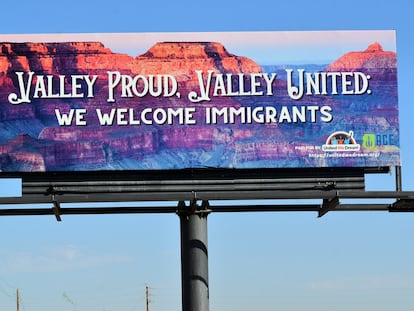Thousands of migrants arrive in Chiapas, seeking asylum in the United States from Mexico’s southern border
Since the summer, the CBP One application has allowed the process to be carried out in this Mexican state, as well as Tabasco. More than 800,000 people have entered Mexico irregularly in the last year
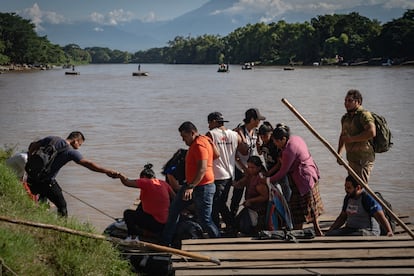

Yessica left Venezuela a year ago, when she was pregnant, to seek a better future far from the economic and political crisis in her country. Her destination was the United States… more than 3,000 miles away.
The little money she saved, the exhaustion of walking with swollen feet and the dangers of the road turned Yessica and her family’s journey into an obstacle course. She’s been traveling with her three children, her husband, her brother and her mother. “We’ve been to Colombia, Panama, Costa Rica, Nicaragua, Honduras, Guatemala and now Mexico,” says the 34-year-old woman, from a shelter in the city of Tapachula, in Chiapas, a Mexican state on the southern border. Her baby was born during the summer rains, in the middle of the Guatemalan jungle.
“It was very hard,” Yessica sighs. “Although the hardest part has been crossing Mexico,” she adds. “They kidnapped us when we crossed the river, they put us in a house. We had to pay $100 to each of them to let us go.” In total, the family had to pay the cartel $800 to escape. Now, they are continuing to wait for the U.S. authorities to give them an appointment to request asylum.
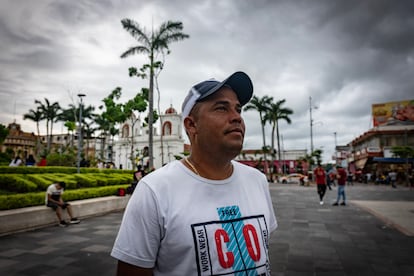
Since the summer began, the CBP One cell phone app — developed by U.S. Customs and Border Protection (CBP) — has allowed for migrants to do the necessary paperwork from the Mexican side of the southern border. Subsequently, they wait until they’re called. This system — added to the humanitarian crises caused by the violence in several countries in Latin America — has doubled the number of irregular entries, especially of individuals migrating from Venezuela, Ecuador, Honduras and Guatemala. The data is overwhelming: according to official data, there have already been 828,000 crossings in 2024, more than what was recorded by the authorities during the entirety of 2023.
These people are fleeing violence, poverty and the effects of climate change. So far this year, at least 97,000 of those who have crossed are children. And while the past images of massive caravans with thousands of people have given way to smaller groups, the trickle of people is constant along this porous border. The authorities, the smugglers, the drug dealers and the boatmen who cross the Suchiate River — as well as the local population — all know it.
“People have a lot of hope in this application — the number of people has increased by more than 100%,” says Father César Cañaveral, a priest who is the administrator of the Belén Migrant Shelter in Tapachula. Most of the individuals in transit feel the same way. “We do it to have a better life,” says Javier — a 37-year-old Venezuelan — who shows EL PAÍS the CBP One application on his cell phone. “And we do it for our children,” a fellow countryman interrupts him.
Javier arrived in Tapachula 15 days ago. Before that, he worked for five years in Chile, but he was ultimately deported. In the central park of Tapachula, next to the church, he meets up with his fellow countrymen to work. The mosaic of faces and accents makes it evident that the city has become one of the main points of migration in Mexico. In the mornings, Javier sells coffee at affordable prices and, in the afternoons, he stands outside shops, offering passersby the opportunity to buy cell phone chips or make a money transfer. From this, he earns a small commission. “Yesterday, I made 150 pesos [about $7], but life is very expensive here; everything costs money,” he shrugs.
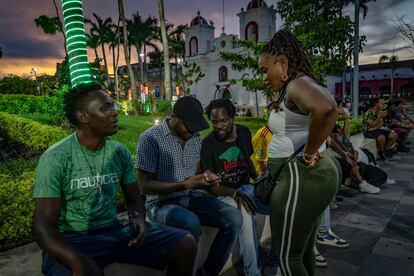
Tapachula reflects what’s happening in other parts of Chiapas. The territorial dispute between criminal groups has reached the border city. Murders, extortions and kidnappings are the order of the day. On October 1, six migrants traveling in the back of a truck — not far from the city — were killed by the Mexican army at a roadblock between Huixtla and Villa Comaltitlán. The victims and the survivors — some from Egypt, El Salvador and Peru — had stamps on their arms to be identified. Human-trafficking has become a business that’s just as profitable — or even more profitable — than drug and arms-trafficking.
This past Monday, the bodies of two migrants from El Salvador were found in a sugarcane field. They had been shot in the head. Meanwhile, organizations and churches have demonstrated against the violence. More than 3,000 Evangelicals gathered two weeks ago in the center of Tapachula to pray and demand a ceasefire. The Catholic Diocese has directly accused the Mexican army of having ties to drug-trafficking and of being involved in kidnapping and extortion. “Migrants are the poorest of the poor and, as a Church, we cannot allow this type of abuse and death,” says Father Cañaveral.
Three young men have just gotten off a raft on the banks of the Suchiate River, the natural border between Mexico and Guatemala. They walk quickly, out of fear. They’re 25, 27 and 30-years-old. They only respond to EL PAÍS to say that they’re from Venezuela and that they fled their country because of the crisis after the recent elections. As they disembark, several men on motorcycles approach the migrants and try to escort them. This is usually the step prior to kidnapping. Afterwards, they’ll be taken to a remote place and forced to get on a truck. Others may be locked up right away, which is what occurred to Yessica and her family.
The Mexican authorities — in response to the heightened violence of these past several weeks — have set up more checkpoints at the exits of the city and on the roads that connect with the neighboring municipalities. The army, the National Guard, the Attorney General’s Office of the State of Chiapas and the municipal police stop vehicles randomly. Between vast fields of green bananas, along the highway that leads to the city of Hidalgo, a National Guard checkpoint watches out for cars that slow down.
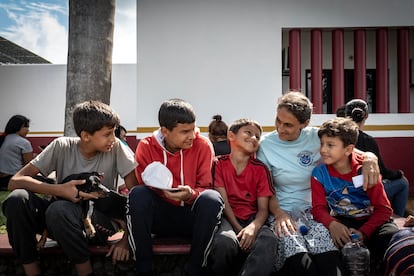
Next to the guards is a National Migration Institute (INM) checkpoint. The agents have just stopped a group of people who were walking along the side of the road: they force them into a van. They’re taken to the Siglo XXI migrant detention station, some 25 miles north. The INM tried to clean up its image after the tragic death of 40 men at an immigration center in Ciudad Juárez, in the Mexican state of Chihuahua. However, despite attempts to renovate the facility, it still looks grim. It is, after all, the largest migrant detention center in the country.
Yolimar, 36, has just left the detention center. She has a sad look on her face. Her body slumps out of tiredness. Despite everything, she jokes with her children and tries to cheer them up. “I thought they were going to have a worse time, but they see all this as an adventure. I try not to let it affect them,” she tells EL PAÍS, while hugging them tightly.
She, her four children and their dog, Serenata, left Caracas a month ago. Their destination: Chicago, where her husband lives. To get to Tapachula, the family crossed the hell that is the Darién Gap on foot. Many die in the thick jungle between Colombia and Panama.
“We saw several dead people,” says Yolimar. “A mother and her daughter died inside a tent and we couldn’t do anything to help them. Then, the police in Costa Rica stole $300 from us. So now, we’ve run out of money to continue,” she laments, with sad eyes. When she arrived in Mexico, she decided to turn herself in to the authorities. The INM gave her a permit to move around the state until her humanitarian visa application comes through. However, her plan is to continue north. If she were to leave Chiapas, she could be detained again, or even deported to Venezuela.
The capital’s shelters are full and most of them exceed their capacity, including the Belén Migrant Shelter. With a maximum of 150 spots, it currently has 270 people accommodated… and more are waiting at the door to be attended. “Migrants haven’t stopped arriving, but with the [CBP One] application, more people began to enter. I would say there’s been a 100% increase compared to last year,” Father Cañaveral estimates.

Despite the high concentration of migrants, the region doesn’t have sufficient infrastructure to care for people in transit. Many of them sleep and survive on the streets, as best they can. Most of these people arrive with the hope of continuing north, although more and more are choosing to stay and live in Mexico, claiming refugee status in the country. The Mexican Commission for Refugee Aid (COMAR) issued nearly 129,000 humanitarian visas in 2023, mainly to citizens of Haiti, Honduras, Cuba and Guatemala. “We’ve noticed that, this year, the number of applications is on the rise. We currently serve 400 people each day,” says César Eloa, head of COMAR’s registration center in Tapachula.
The implementation of CBP One at the southern border has made it possible to reduce the concentration of migrants in border cities such as Juárez, Tijuana, or Piedras Negras. However, the app doesn’t save those who are fleeing their countries from the risks involved in the journey. Migrants also face total uncertainty afterwards. Once the appointment date is assigned, they must present themselves at the indicated border post, by their own means. The procedure remains confusing for many: misinformation is rampant. “The authorities try to tire these people out and disorient them so that they give up, but they’ll push forward, even if it costs them their lives,” says Father Cañaveral, director of the shelter.
Drug traffickers, the Mexican authorities and opportunists of all kinds take advantage of the lack of information about the immigration processes, so that they can profit from those struggling to get across the border. For instance, a fake message has been circulating in WhatsApp groups about a caravan that’s been invited by the Episcopal Conference and the U.S. Embassy in Mexico, which is totally false. Both entities denied any such coordination when queried by EL PAÍS.
“I suppose that, when they give me the appointment, a [Mexican] Immigration truck will take us to the border,” says Omar, a Colombian citizen who has just arrived in Tapachula. For many new arrivals, the procedure is a labyrinth that’s difficult to decipher. Or an insurmountable virtual wall.
Sign up for our weekly newsletter to get more English-language news coverage from EL PAÍS USA Edition
Tu suscripción se está usando en otro dispositivo
¿Quieres añadir otro usuario a tu suscripción?
Si continúas leyendo en este dispositivo, no se podrá leer en el otro.
FlechaTu suscripción se está usando en otro dispositivo y solo puedes acceder a EL PAÍS desde un dispositivo a la vez.
Si quieres compartir tu cuenta, cambia tu suscripción a la modalidad Premium, así podrás añadir otro usuario. Cada uno accederá con su propia cuenta de email, lo que os permitirá personalizar vuestra experiencia en EL PAÍS.
¿Tienes una suscripción de empresa? Accede aquí para contratar más cuentas.
En el caso de no saber quién está usando tu cuenta, te recomendamos cambiar tu contraseña aquí.
Si decides continuar compartiendo tu cuenta, este mensaje se mostrará en tu dispositivo y en el de la otra persona que está usando tu cuenta de forma indefinida, afectando a tu experiencia de lectura. Puedes consultar aquí los términos y condiciones de la suscripción digital.
More information
Archived In
Últimas noticias
There is as much life left to discover on planet Earth as that which is already known
Dozens presumed dead, around 100 injured in fire at Swiss Alps bar during New Year’s celebration
Is porn for women different from conventional porn? We spoke to those who make it
Cartagena de Indias is sinking: What can the city do to mitigate it?
Most viewed
- Sinaloa Cartel war is taking its toll on Los Chapitos
- Reinhard Genzel, Nobel laureate in physics: ‘One-minute videos will never give you the truth’
- Oona Chaplin: ‘I told James Cameron that I was living in a treehouse and starting a permaculture project with a friend’
- David King, chemist: ‘There are scientists studying how to cool the planet; nobody should stop these experiments from happening’
- Why the price of coffee has skyrocketed: from Brazilian plantations to specialty coffee houses

